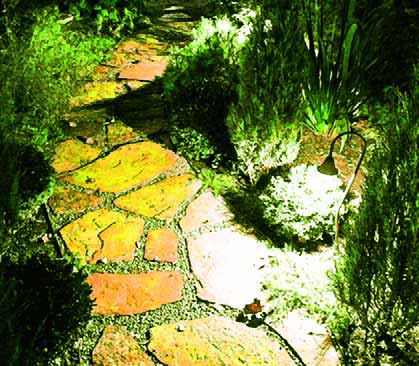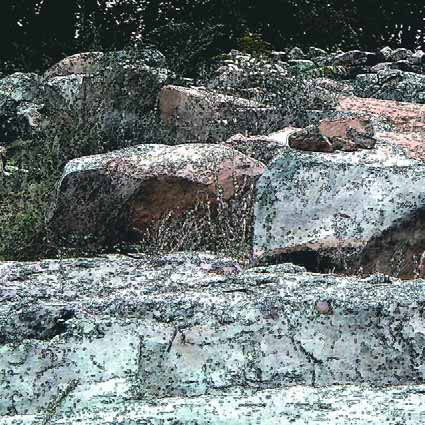placement
Those of us who are designers and builders of full-scale outdoor environments (you know who you are) face a distinct challenge: In our work for our clients, we are expected to provide the outline and details for a huge range of project elements, from watershapes and patios to plantings and walkways and more. That list, at least so far as clients are concerned, also includes appropriate lighting, but that is not always something on which we focus. Indeed, lighting design is seen as a specialty even by those who tackle almost every other project feature - and there's no problem with that unless
My love of nature started with a rock collection I had as a child: My fascination with the simple beauty of those small pieces of stone hit me early in life and never left. Several years later, my outlook was dramatically expanded when a wealthy uncle of mine paid to have a formal Japanese garden built for his home in Boulder, Colo. Ever since, I've had a profound appreciation of archetypal Japanese gardens and the way they celebrate nature through landforms, rocks, plants and water. By the time I was in high school, I had already decided that my career was going to involve working outdoors, and from that time forward, my prime interest was in bringing the techniques and disciplines of Japanese gardens into the greater American landscape both where I grew up in the Pacific Northwest and elsewhere. For 30 years now, I've worked as a landscape artist in that region - for 15 years in Portland and for the last 15 in Eugene, Ore. Although many of my designs are not what you could describe as "Japanese gardens" per se, everything I do is informed and influenced by those traditions. I bear no grudge of any sort against the beauty of gardens in the Western European tradition, but to my mind, there's nothing in landscape design that harmonizes more seamlessly with nature than
My love of nature started with a rock collection I had as a child: My fascination with the simple beauty of those small pieces of stone hit me early in life and never left. Several years later, my outlook was dramatically expanded when a wealthy uncle of mine paid to have a formal Japanese garden built for his home in Boulder, Colo. Ever since, I've had a profound appreciation of archetypal Japanese gardens and the way they celebrate nature through landforms, rocks, plants and water. By the time I was in high school, I had already decided that my career was going to involve working outdoors, and from that time forward, my prime interest was in bringing the techniques and disciplines of Japanese gardens into the greater American landscape both where I grew up in the Pacific Northwest and elsewhere. For 30 years now, I've worked as a landscape artist in that region - for 15 years in Portland and for the last 15 in Eugene, Ore. Although many of my designs are not what you could describe as "Japanese gardens" per se, everything I do is informed and influenced by those traditions. I bear no grudge of any sort against the beauty of gardens in the Western European tradition, but to my mind, there's nothing in landscape design that harmonizes more seamlessly with nature than
In all my many years of working with water, I've never grown tired of its remarkable beauty and complexity - or of the variations it encompasses, the ways it changes and the endless fascination it offers to those who come into its presence. At the heart of water's ability to inspire us and rivet our attention is its capacity to reflect. There's something truly magical about the way water mirrors the sky, a surrounding landscape, nearby architecture or a well-placed work of art. It's a gift of sorts, a timeless bounty that has captured imaginations ever since Narcissus fell in love with
In all my many years of working with water, I've never grown tired of its remarkable beauty and complexity - or of the variations it encompasses, the ways it changes and the endless fascination it offers to those who come into its presence. At the heart of water's ability to inspire us and rivet our attention is its capacity to reflect. There's something truly magical about the way water mirrors the sky, a surrounding landscape, nearby architecture or a well-placed work of art. It's a gift of sorts, a timeless bounty that has captured imaginations ever since Narcissus fell in love with
As milestones go, the project depicted in these pages has been a big one for me - and for lots of other people as well. The grand estate with its outsized home is located in the countryside near Hanover, Pa., a remote setting that offered a set of challenges that has in many ways redefined what is and isn't possible in a whole region when it comes to watershape design, engineering and construction. A full two-and-a-half years in the making (a period broken up, of course, by stretches in which there was no activity on site), this stands as one of
Bridges have been important to humanity for thousands of years. They've provided avenues of travel between disconnected spaces and have, as a result, been critical to commerce, settlement, warfare, travel and even poetry and literature. To this day, they are iconic in certain cities or regions (think Paris or New York), and there has always been a distinctly romantic air that accompanies their obvious utility. My relationship with bridges in general (and with wooden bridges in particular) began during my childhood near Nebraska's Niobrara River. The big, load-bearing structures crafted to span that river in the late-19th and early-20th centuries absolutely fascinated me. I'd spend hours climbing on those old structures and was amazed by the way they creaked as their tension and compression members supported truly formidable weights. At the same time, I came to value the presence of
Bridges have been important to humanity for thousands of years. They've provided avenues of travel between disconnected spaces and have, as a result, been critical to commerce, settlement, warfare, travel and even poetry and literature. To this day, they are iconic in certain cities or regions (think Paris or New York), and there has always been a distinctly romantic air that accompanies their obvious utility. My relationship with bridges in general (and with wooden bridges in particular) began during my childhood near Nebraska's Niobrara River. The big, load-bearing structures crafted to span that river in the late-19th and early-20th centuries absolutely fascinated me. I'd spend hours climbing on those old structures and was amazed by the way they creaked as their tension and compression members supported truly formidable weights. At the same time, I came to value the presence of
Throughout my design career, I have repeatedly expressed to clients that their gardens are dynamic, constantly changing and only to a very minimal degree under anyone's control. You can plant, water, fertilize, cultivate and prune - "and if you're lucky," I say, "you'll enjoy the fruits of your labors in the form of a visual feast." But that's only if you're lucky, I continue, because no matter what we do to nurture gardens, they are always subject to the whims of Mother Nature. From the smallest annual to the most statuesque tree, no garden is immune. Even though I've always had this talk with clients, however, I've always held the mild belief that it's possible in some ways to stay a step ahead of her by being vigilant and active. I learned the other day at first hand that she



















